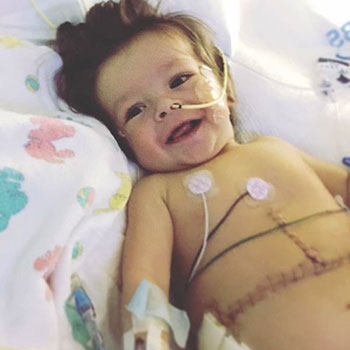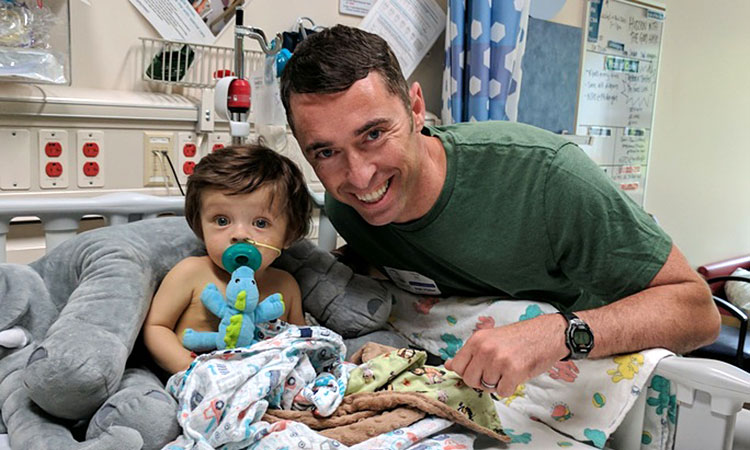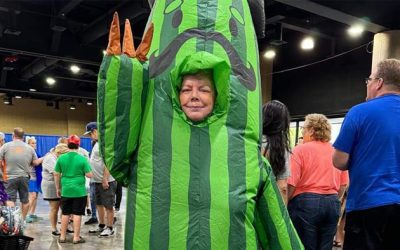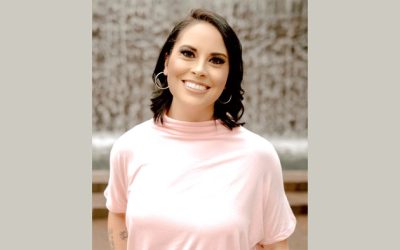Jordan and Morgan Hill carry with them everywhere a custom-made coin inspired by their son’s liver transplant and the man who saved his life.
Morgan had the coin made weeks before his older brother, United States Army Special Operations Command Lt. Col. Trevor Hill, flew to Seattle from his home in North Carolina to donate part of his liver to his 8 ½-month-old nephew, Hudson.
“My brother saved our son’s life,” Morgan said. “Trevor has had what is called a challenge coin throughout his military career. It’s a sign of respect. It’s a symbol of someone’s unit and their life, and I wanted him to have one representing the incredible gift he gave us.”
As Hudson’s first birthday approaches, the coin often finds its way into Morgan’s hands. One side of the coin is embossed with a green and white ribbon with the words “LIVER TRANSPLANT” flanked by Hudson’s name to the upper left and Trevor’s name to the lower right. The other side features “#freehudson” at the top. It also includes the logos of Seattle Children’s and the University of Washington Medical Center, where surgical teams coordinated care to complete one of two liver transplants in the United States this year involving an infant and a living donor who was a relative other than a parent or sibling, according to United Network for Organ Sharing.
Morgan Hill had challenge coins made to commemorate the liver transplant that saved Hudson’s life. He and his wife have given replicas of the coin to people who have been part of their journey. The Hills give replicas of the coin to those who become part of Hudson’s lifelong journey. It’s a memento of their family story and a pocket-sized piece of perspective.
“It reminds me that if my little guy was smiling with all he was going through in the hospital, then whatever the problem is, we can get through it,” Morgan said. “It keeps me calm.”
 At 2 ½ months old, Hudson was in the intensive care unit recovering from septic shock when he was evaluated for a liver transplant at Seattle Children’s Transplant Center in January 2017. He had already been through two surgeries and had spent more time in hospitals than at home. Hudson’s bile duct wasn’t functioning and the bile produced by his liver to help digest fats wasn’t reaching his gallbladder and intestine. The smiling boy with big blue eyes and an incredible head of dark brown hair had biliary atresia.
At 2 ½ months old, Hudson was in the intensive care unit recovering from septic shock when he was evaluated for a liver transplant at Seattle Children’s Transplant Center in January 2017. He had already been through two surgeries and had spent more time in hospitals than at home. Hudson’s bile duct wasn’t functioning and the bile produced by his liver to help digest fats wasn’t reaching his gallbladder and intestine. The smiling boy with big blue eyes and an incredible head of dark brown hair had biliary atresia.
“Biliary atresia is the most common reason kids get liver transplants,” said Dr. Andre Dick, transplant surgeon at Seattle Children’s and associate professor of surgery at the University of Washington School of Medicine. “If the bile cannot leave the liver, it damages the organ and eventually leads to liver failure.”
The Hills learned that a living donor was a possibility for Hudson. A living donor transplant offers several advantages and can drastically reduce wait time for new organs.
The Hills learned that a living donor was an option soon after Hudson’s transplant evaluation began.
“With a living donor, you can often better prepare the recipient for surgery, set a more convenient transplant schedule and hopefully find a better genetic match to decrease the risk of organ rejection,” Dick said.
If a living donor match was found, it also meant that Hudson would be able to get the transplant much sooner because he would not have to wait for deceased donor match.
“There are always more people waiting for donation than organs available,” Dick said. “For those who do choose to donate an organ, there is no greater gift anyone can give.”
For living donor transplants at Seattle Children’s, practitioners at UW Medicine’s Liver Transplant Program evaluate and perform all procedures involving the adult donor.
“All of us here in the transplant program are part of the same system and have trained together at UW,” Dick said. “We all know one another and that’s why our system works really well.”
A living donor candidate needs to be an adult who has the same blood type as the recipient and a healthy liver. Only a portion of the liver is needed for a living donor transplant because the organ can regenerate for both the donor and recipient within months if there are no complications.
Answering a call to action
Special Forces Command Lt. Colonel Trevor Hill, also known as Uncle Trevor to Hudson, traveled across the country to donate a portion of his liver to his nephew.
When Hudson’s parents learned they did not qualify as donors, they reached out to close friends and family asking for help.
A response came quickly.
“Trevor called to confirm Hudson’s blood type,” Morgan said. “Then he told me his flight to Seattle was scheduled for Feb. 2. He had already spoken to UW about a donor evaluation.”
The 43-year-old husband and father to two girls has a history of showing up for his family when they need him most. Morgan recalls his brother arriving home unannounced from military training and active duty in Iraq to attend events that had special meaning for his siblings.
“It’s a family member and I’m going to do whatever I can to help,” Trevor said. “I’ve taken a lot of risks in my life. It really wasn’t a tough decision.”
For the military veteran of 20-plus years, it was also a way to pay it forward.
“I’ve experienced loss in my career and I’ve had my life saved by two Green Berets who pulled me out of a burning Humvee,” Hill said. “This was a chance for me to give back.”
The news came on the third day of Trevor’s evaluation that he was a match.
“We were overjoyed,” Morgan said. “Hudson was dying. His liver wasn’t functioning properly. The range of emotions was all over. It’s an incredible gesture for someone to give like that.”
With Hudson’s health beginning to stabilize, doctors decided to delay the transplant until July 10, allowing him to grow stronger for surgery.
Trevor was granted leave for the transplant. He returned to Seattle the day before surgery and visited Hudson at Seattle Children’s, who soon would share a special connection with his uncle.
“It was surreal to see Trevor with Hudson, who was giggling on the bed, knowing they’ll soon be going through hours of surgery,” Morgan said.
Early the next morning, Trevor was taken into surgery at UW Medical Center. His surgery was led by surgeons Dr. Martin Montenovo and Dr. Patrick Healey, chief of transplantation Seattle Children’s.
Two miles away, Seattle Children’s Director of Transplant Dr. Jorge Reyes and Dick worked with the transplant team to remove Hudson’s liver and reconstruct his bile duct. Both surgical teams were in close communication to ensure the portion of Trevor’s liver was transported at the exact right time.
Trevor’s surgery was completed in mid-afternoon. Hudson remained in surgery into the night as surgeons connected the arteries and veins of his new liver to his body and ensured the organ was functioning.
Trevor visited Hudson at Seattle Children’s days after they both underwent surgery as part of a liver transplant.
Four days after surgery, Trevor was discharged and visited Hudson, who had already lost the yellowish tint to his skin and eyes brought on by the biliary atresia before surgery.
“It was fascinating to see Trevor and Hudson looking opposite each other at their bellies,” Morgan said. “That was powerful and everything became a little more meaningful in that moment.”
It was special for Trevor, too.
“My first thoughts were that Hudson had fought through so many challenges, but he was going to make it,” Trevor said. “It was amazing to see in person what the transplant team had accomplished in a day.”
Trevor spent another week recuperating before flying back to his wife, Katie, and two young daughters in North Carolina.
Hudson had a longer road in front of him. He spent 40 days in the hospital recovering as the care team worked through some post-surgery complications. Jordan and Morgan alternated spending nights at the hospital and were involved in every step of Hudson’s care.
“The team at Seattle Children’s became an extended part of our family,” Jordan said. “It was a comfort to know that they were acting in Hudson’s best interest. Their goal was our goal.”
After their long journey, Hudson was discharged on Aug. 18.
Hudson turns 1 year old in October and is back home with his parents following the better part of a year spent in hospitals.
The Hills want people to know their story and the impact organ donation can make for the 117,000 people in the U.S. currently waiting for a lifesaving transplant.
“It would be special to us if our story helped another family going through the transplant process,” Jordan said.
Jordan and Morgan are also looking forward to what they thought they’d be doing before health complications took over their lives: play dates; going out to dinner as a family; family pictures; and outdoor activities.
Hudson will turn 1 year old on Oct. 27. He’s gaining weight and his big smile has a few more teeth than it used to. He no longer needs a nasogastric tube to constantly push nutrients into his body, and his famous brown hair keeps growing as he learns to crawl and stand.
The scars on Hudson’s abdomen are a reminder of the challenges his family has faced and the incredible gift of life from his uncle Trevor. So are the challenge coins.
“We’re still giving them to people,” Morgan said. “They’re a symbol of all we’ve been through as a family.”



